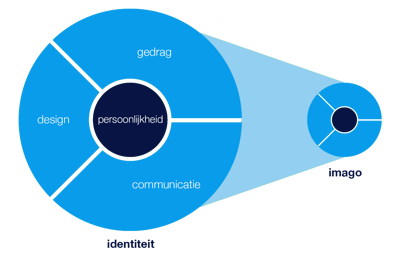
Who has not thought during their student years, "all those theoretical concepts, they won't have any practical use later on." However, at some point in your career, you will have to formulate a mission or describe the identity of the organization you work for. And then it turns out that those definitions need to be revisited once again.
In 2013 (over 10 years ago already!), as a student, I wrote a blog article about the concepts of identity, image, and reputation. The article has been in our top 5 most viewed blogs for a long time! So it is not a luxury to, once again, recapitulate all those important communication concepts.
In this blog article, I will provide definitions of terms such as mission, vision, identity, core values, and positioning.
Definition of mission and vision and the difference between them
The vision and mission are important guiding principles for a company. With a mission, you indicate who you are, what you do, and what you want to achieve. It is a deeper motivator or underlying purpose. The mission remains the same over a longer period and is derived from the vision. The vision is inspiring and provides a visionary and ambitious image of what you want the company to be: your ideal situation. The vision encompasses the beliefs and values of your company and reflects your perspective on life and society. Because the world around you is changing, this future outlook can also change over time. The table below clearly shows the differences between the mission and vision. Describe your mission and vision concisely and ensure internal explanation and promotion. Ideally, every employee in your company should be able to remember the mission and vision.
|
Mission |
Vision |
|
What we stand for |
What we go for |
|
Focused on the organization |
Focused on the environment |
|
Who are we? |
How do we interact with the outside world? |
|
Identity, values |
Future, dream |
|
From a distant past |
Towards the distant future |
|
Essentially timeless |
Can be adjusted |
Definition identity
Identity is an image that you have of your own organization: who you are. The identity, also known as corporate identity, brand identity or organizational identity, is what makes the company unique. Thanks to a clear identity the public can make connections and associate with your brand. For example, you directly associate Dove with natural beauty and Apple with design. The identity comprises of the elements: vision, mission, core values, ambitions, culture and the personality of your organization. In the corporate identity mix you determine your brand on the basis of three factors:
- Behavior: how you walk. How you operate says something about your company. For example: how you produce your products or how you treat your employees.
- Communication: how you talk. The tone-of-voice in all your verbal communications.
- Design: how you look. This includes your brand style with logo, font styles, color settings, etc.

Contrary to the image, when you view your organization from the perspective of outsiders, you look at yourself in terms of identity. Ideally, your image is a reflection of your identity. The better and clearer you convey your identity, the greater the chance that your image aligns with your identity.
Definition core values
The core values are part of your identity. They shape the essence of the company culture, describing who you are and what you value. Core values are not invented; they are discovered and felt within your organization. Examples of core values are innovative, engaging, and honest. You may notice that certain core values are common among many organizations, making them less distinctive. The differentiating factor lies in how these core values are demonstrated in practice. To test this, you can use the BBT formula: Promise, Proof, and Tone. Examine each core value to determine the supporting evidence you have and whether this evidence translates into a specific tone in your text, visuals, and actions.
Definition brand positioning
Based on your unique identity you can distinguish your company. You do this by positioning yourself in the market. Why would the client choose specifically for your product or service? And how do you distinguish yourself from your competitor? Brand positioning revolves around creating a distinguishing brand promise: 'For ... (customer), who is seeking ... (need), ... (brand or organization) offers ... (benefit) as an advantage.' Brand positioning is closely related to your marketing strategy. In this, you define your ideal customer, examine their needs, and determine your Unique Selling Point.
Getting started with formulating an identity for your company
You probably did not just read this blog article for no reason. Perhaps you're in the process of rebranding or want to redefine your vision. Now that I refreshed your theoretical knowledge, you can apply it in practice. Do you have a question? Feel free to get in touch or check out more information about brand identity.
Bron: Michels, W. (2010). Communicatie handboek. Noordhoff Uitgevers: Groningen.

